To Split or not to Split ... That is the Hollywood Question! |
This article first appeared in |
| Written by: Keith H. Swadkins M.B.K.S., The International Cinerama Society | Issue 63 - December 2000 |
|
|
Further in 70mm reading: |
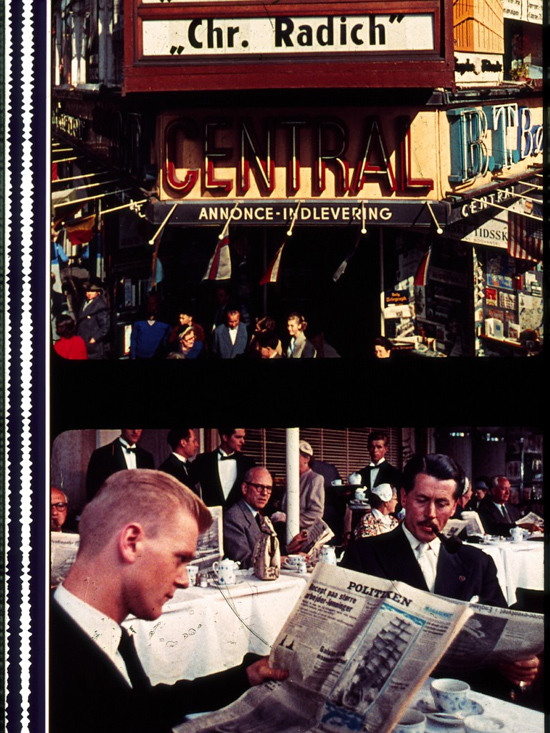 Full
color extraction of three panel "Windjammer", printed to single panel 35mm
widescreen & Technicolor. Each frame is even turned from 6-perf to 4 perf by
cropping top and bottom of the original 6-perf frame. Full
color extraction of three panel "Windjammer", printed to single panel 35mm
widescreen & Technicolor. Each frame is even turned from 6-perf to 4 perf by
cropping top and bottom of the original 6-perf frame.The opposite process of producing three separate prints from a Widefilm negative, for use in a three projector set-up, is known as EXTRACTION or SPLITTING. Ten years before Abel Gance made his historic multi-panel (Polyvision) production “Napoleon" (1926), he had experimented with a triple camera for his short film "Barberousse" (1916), although, for projection, the three images were combined onto one 35mm film. "Napoleon" features several triple screen sequences, using the enlarged screen for both montages and panoramas. In major European cities the film was presented using triple projectors but when MGM, who held the USA rights, released the film, it was as a shortened version with selected triple screen sequences printed side by side in Letterbox format. For some scenes in his film "Contruire un Feu" (1927), French director Claude Autant-Lara used a triple camera. In this case, for projection purposes, the three pictures were combined, side by side, onto one film, using Henri Chretien´s newly developed anamorphic lens to compress the images sideways. "This is Cinerama" arrived in Hollywood in April 1953 with the adapted re-opening of the WARNER CINERAMA THEATRE on Hollywood Boulevard. Two years later, the press announced that the MELROSE HOLLYWOOD THEATRE had also been equipped for 3-Strip projection, describing it as "Fox's West Coast Demonstration Theatre and Projection Lab". Never intended as a public 3-Strip theatre, this installation opened on June 23rd 1955 with a press show featuring scenes from "This is Cinerama". At this time, Panavision Inc. and MGM were jointly developing a method of optically splitting 65mm negatives into three panel Cinerama prints and in October 1956 they demonstrated at the Melrose, a 3-Strip print of selected scenes from MGM's Camera 65 production "Raintree County". Camera 65 lenses employed an anamorphic lens to compress a similar aspect ratio to Cinerama onto the standard 65mm frame. In the printer a similar lens removed the squeeze before printing the resulting flat image, one panel at a time, onto 35mm film in the six perforation Cinerama format. Described as showing the feasibility of deriving Cinerama type projection from an anamorphic 65mm original, it was reported that the forthcoming Camera 65 production of "Ben Hur" would be considered for splitting. This was probably the source of the rumour, circulating in the early 60's, of a 3-Strip print of "Ben Hur" although there is no evidence that such a print was ever made. A veteran employee of Cinerama Inc told me that Cinerama were strongly opposed to splitting. Finally, in November 1957, the Melrose was used for the press showings of "Cinemiracle Adventure" retitled "Windjammer" prior to it's premiere in April 1958. In 1959 Cinerama Inc. started discussions with MGM on the possibility of producing Cinerama feature films and, to this end, Cinerama´s technical equipment was transferred from it's home at Oyster Bay, Long Island to a new studio base at the FORUM THEATRE, Los Angeles. The first two features were to be, "The Wonderful World of the Brothers Grimm" and "How the West Was Won". The script for "How the West Was Won" called for several large scale action scenes, two of which MGM decided could be produced by splitting from existing 70mm material, saving the cost of staging and filming new material. Hence the establishing shots of the Civil War sequence were taken from footage originally shot for "Raintree County" (Camera 65), whilst a shot of the Mexican Army advancing was an outtake from "The Alamo" (Todd-AO). |
|
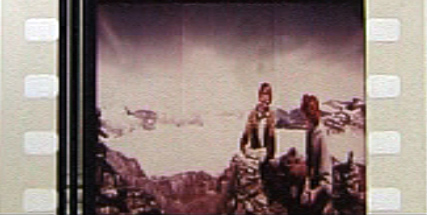 Faded
combination of three panel Cinemiracle "Windjammer", projection-printed by
Film Effects of Hollywood to anamorphic 35mm Eastmancolor. Note the join
lines. Faded
combination of three panel Cinemiracle "Windjammer", projection-printed by
Film Effects of Hollywood to anamorphic 35mm Eastmancolor. Note the join
lines. In both cases the required shots were split in the laboratory and the resulting triple negative edited into the 3-Strip camera footage. One problem to be overcome was the difficulty of using back projection and traveling matte in the 3-Strip process. Ultra Panavision, virtually identical to Camera 65, was used for these although the vast majority of the movie was filmed in 3-Strip. Smaller, lightweight Ultra Panavision cameras were also used to supplement the six huge 3-Strip Cinerama cameras when filming some of the action sequences. For editing and post production purposes, the laboratory provided a combined 35mm anamorphic print enabling existing, conventional production techniques to be used, all 3-Strip operations and viewing taking place downtown at Cinerama´s Forum Studio. In addition to 3-Strip release prints, a full-length composite 65mm negative was made, from which both 70mm flat and 35mm anamorphic prints for later release were produced. "How the West Was Won" was eventually released in both 70mm and 35mm anamorphic versions but there is no record of any 70mm prints of "The Wonderful World of the Brothers Grimm" being produced. Sadly the germ which was to kill Cinerama had now been let loose. If you could split 65mm negatives to produce 3-Strip, why not do away with the 3-Strip step completely and go straight to 65mm origination? Ultra Panavision had virtually the same aspect ratio although it had a limited angle of view compared with the 3-Strip camera. Forget the impact of 3-Strip, why not shoot in Ultra Panavision and split for the Cinerama Theatres? The audience involvement and visceral impact of Cinerama that had made it unique, were thus sacrificed on the altar of economics. The success of "How the West Was Won" had inadvertently opened it's jugular vein. |
|
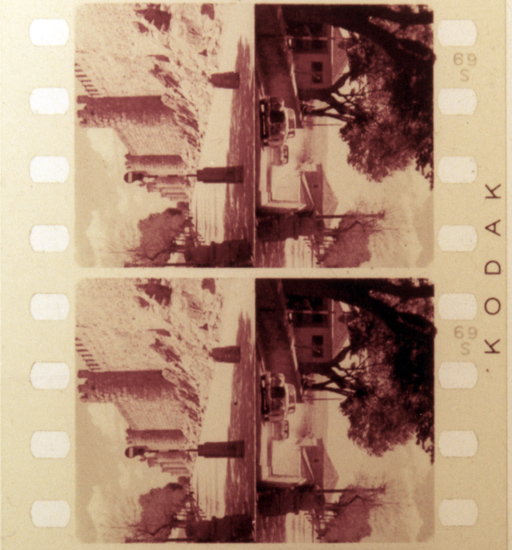 Faded
ARC-120 35mm frames split from 35mm 8-perf Technirama. Squeeze removed.
Picture split vertically down the centre of the frame. The two halves
rotated to lie, foot to foot, on a single 35mm frame. Faded
ARC-120 35mm frames split from 35mm 8-perf Technirama. Squeeze removed.
Picture split vertically down the centre of the frame. The two halves
rotated to lie, foot to foot, on a single 35mm frame.For some time, Cinerama Inc. had been developing a new, single strip Cinerama process which exactly duplicated 3-Strip Cinerama on one film. The key to the new system was a revolutionary new lens and camera, the camera using 35mm film running horizontally, advanced 16 perforations per frame. Eventually the aim was to develop a 35mm horizontal 16 perforation projector to complement the new process but, in the meantime, it was decided to extract 3-Strip prints from the new negative for the existing theatres. A purpose-built printer was reputedly ordered and delivered to Cinerama´s Oyster Bay Studio for trials. Then, in a moment of supreme folly, Cinerama Inc. abandoned the new process, opting instead for a system of projecting any 70mm print onto their deeply curved screens. Eight days after the premiere of "The Wonderful World of the Brothers Grimm", a press show was held at LOEW'S CINERAMA, New York when an excerpt from "It's a Mad, Mad, Mad, Mad World", split into 3-Strip, was shown to the press together with original 3-Strip make-up and wardrobe tests for "The Greatest Story Ever Told". At that time the format for the eventual release of these two movies was reported to still be under discussion. In the event, both movies were filmed and released in Ultra Panavision, special 70mm prints with "rectified" image geometry being supplied to the Cinerama theatres. In 1957, the USSR introduced KINOPANORAMA, their own version of Cinerama. After producing several travelogues and dramatic movies in the process, they also changed to anamorphic 70mm production with KINOPANORAMA 70. However, unlike the USA, they often released both 70mm and 3-Strip extraction versions of these later films. Additionally 3-Strip extraction prints of at least two FLAT 70mm productions were released. In July 1960, the CineMiracle Pictures Corporation obtained the rights to release Mike Todd's Todd-70 Smell-O-Vision film "A Scent of Mystery" (1959), without the odours, under a new title "Holiday in Spain". 3-Strip CineMiracle extraction prints were ordered from Technicolor but legal problems delayed the film's release. Subsequently, Cinerama Inc purchased the CineMiracle Company, thus taking over the distribution of both "Windjammer" and "A Scent of Mystery". The 3-Strip version of "Scent of Mystery" which maintained the film's original 2.2:1 format by slightly masking the sides of A & C panels, received limited showings, the majority of play dates using 70mm prints. At the Forum Theatre Studios, Cinerama were experimenting with the conversion of their travelogues directly to 35mm anamorphic prints but the results proved unsatisfactory. However a 35mm anamorphic print of "Windjammer" is understood to be held in a European archive and a flat version was also produced by inter-cutting material from all three panels. |
|
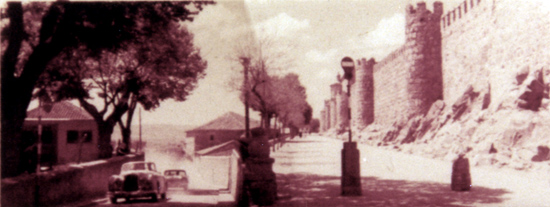 Possibly
the strangest example of splitting appeared in August 1960, when the PALACE
CINEMA, Blackpool, England presented
"Honeymoon" (1959) in
MIRACLE ARC 120 (A.K.A: WONDERAMA). Purely a projection system, the process
was described in contemporary accounts as requiring a special print,
produced by removing any squeeze, splitting the picture vertically down the
centre of the frame and rotating the two halves to lie, foot to foot, on a
single 35mm frame. During projection the ARC 120 prismatic projection lens
rotated the two halves back to form a single image on a specially installed
"deeply curved" screen, an "integral rotating shutter"
concealing the merge line. "Honeymoon" was a conventional
Technirama production, the laboratory making two of the special ARC 120
prints from a 35mm anamorphic interneg. The Stereo sound was carried as two
magnetic tracks outside of the perforations. I failed to see this oddity
which ran only four weeks before closing, the theatre suffering the same
fate a few weeks later. It has taken considerable research to unearth any
information on this long forgotten process. I can find no record of ARC 120
ever being shown again although "Honeymoon" still occasionally
appears in afternoon TV schedules. Possibly
the strangest example of splitting appeared in August 1960, when the PALACE
CINEMA, Blackpool, England presented
"Honeymoon" (1959) in
MIRACLE ARC 120 (A.K.A: WONDERAMA). Purely a projection system, the process
was described in contemporary accounts as requiring a special print,
produced by removing any squeeze, splitting the picture vertically down the
centre of the frame and rotating the two halves to lie, foot to foot, on a
single 35mm frame. During projection the ARC 120 prismatic projection lens
rotated the two halves back to form a single image on a specially installed
"deeply curved" screen, an "integral rotating shutter"
concealing the merge line. "Honeymoon" was a conventional
Technirama production, the laboratory making two of the special ARC 120
prints from a 35mm anamorphic interneg. The Stereo sound was carried as two
magnetic tracks outside of the perforations. I failed to see this oddity
which ran only four weeks before closing, the theatre suffering the same
fate a few weeks later. It has taken considerable research to unearth any
information on this long forgotten process. I can find no record of ARC 120
ever being shown again although "Honeymoon" still occasionally
appears in afternoon TV schedules.As part of a 1966 US/USSR cultural exchange, an independent producer compiled sequences from several of the USSR's Kinopanorama movies under the title "Cinerama's Russian Adventure" The panels were combined, producing a 65mm negative which was used for the majority of release prints although at least one 3-Strip print was circulated. Regrettably no prints nor negatives are known to have survived. A reciprocal Cinerama compilation, envisaged for release to the USSR Kinopanorama theatres, was abandoned. Finally, in 1972, Cinerama Inc tried to revitalize their dwindling fortunes by reissuing "This is Cinerama", this time as a 70mm combined print. It proved to be a poor facsimile of the original, even being shown in non-Cinerama theatres. It only confirmed that the original Cinerama process was the star and, shorn of that, it was just another travelogue. This proved to be the death knell for the great days of 3-Strip until the enthusiasts discovered the grave of Cinerama in 1986 and began the long, long road to reincarnation which is only now coming to fruition. |
|
| Go: back
- top - back issues Updated 22-01-25 |

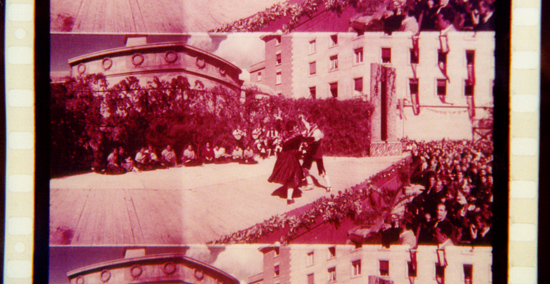 Faded
70mm frame with example of combining three panel Cinerama to 65mm by
Faded
70mm frame with example of combining three panel Cinerama to 65mm by